Environmental Education and NGSS in an Era of Uncertainty
By Juanita Chan and Lizbeth Mariscal
“Environmental issues lend themselves to cross-disciplinary integrative learning and science teachers are central to the effort to bring environmental literacy to every California child...At the heart of this broader integrative effort is three-dimensional science learning (NGSS) that emerges from the facilitation of rich environmental learning experiences.”
~CSTA Position Statement for Environmental Literacy for All California Students
The idea of using the environment to drive science instruction is a daunting task at the classroom level, but thinking about supporting the wide scale changes necessary to do that for every student in a district can look nearly impossible. As we currently stare down one global crisis, some may ask, “Who cares about the environment?”We must recognize that there will be other crises, and that science, climate, environmental and data literacy are the survival skills of the future. The changes required by NGSS have often been described as a shift from learning facts, to learning about how to think about facts and how to use that information. Never has this been more important for the students of California.
If scientific literacy is going to be a reality for all of California’s students, then every person that has a voice in the system must use it to prepare every student for the ability to advocate for their own health and wellness and the well-being of their families and community. We confront this noble cause recognizing that currently in California the community that you grow up in has a direct impact on your life expectancy. In neighborhoods within the concrete jungle, environmental literacy lessons are the most empowering and hold the keys to survival. As a science advocate and teacher leader, we may question what responsibility we hold? The answer can be found in one of the most commonly referenced pieces of environment-themed children’s literature available:
“Unless someone like you cares a whole awful lot, nothing is going to get better. It’s not.” ~The Lorax
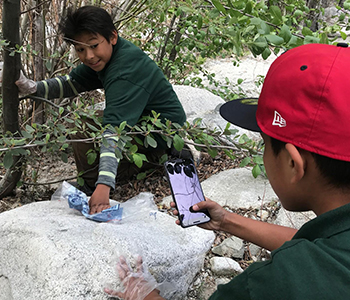
5th grade students geocaching litter

2nd grade students participating in a Farmer’s Market at the library
It’s time for a change. In the spirit of exploring cross-cutting concepts, we must not fail to recognize the systems and subsystems that affect science instruction.
Systemic Changes
Environmental literacy in all NGSS instruction requires vertical thinking about student experiences. Deep thinking about environmental phenomena requires an investment of time. Students should continually return to a topic as they mature throughout a schoolyear and over their academic career.
In the classroom, consider:
- Is there a central annual theme called out by the curriculum?
- Do I have a particular environmental passion?
- Is there a relevant community topic this year (legislative, health, social)?
- Can I partner with an informal environmental education provider?
In a support role, consider:
- Is there a grade-level or a teacher that is most open to collaboration?
- Can there be a keystone opportunity per grade level?
- Are there equitable experiences for all students at a grade level or site?
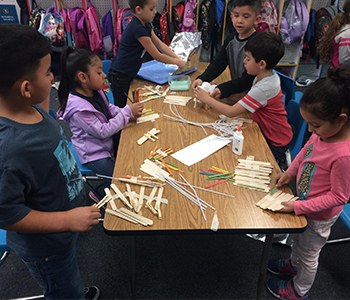
Kindergarteners building a shade structures

8th graders completing an online simulation

7th graders building a lean-to structure
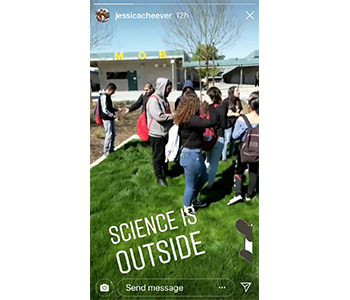
Instastory post of 10th graders doing science outside
Meaningful Collaboration
Incorporating phenomena that lead to greater environmental literacy requires careful consideration of all the resources available in your learning environment. Reach beyond teacher colleagues and build alliances with the community scientists schoolwide. Think about expanded learning areas (where many of these partners can be found): cafeteria, multi-purpose rooms, restrooms, water fountains, solar panels, blacktops/heat islands, playgrounds or yards, gardens, grassy patches in the quad. These areas will help you determine the knowledge and skills of the people who work there: grounds and maintenance workers, custodians, nutrition services workers, and Career Technical Education (CTE) teachers.
Evaluate:
- What is the expertise of this partner? (This may require many conversations with the potential partner)
- Is it best to partner on a whole project or one part of a project?
- Does this partner have to get approval from a supervisor to support your class?
- Are there any joint interests?
- How might your partner benefit from this project?
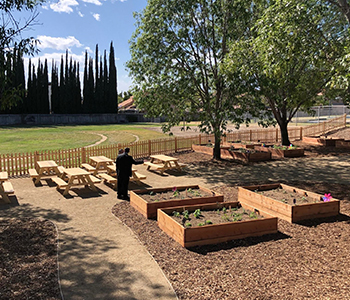
School Garden
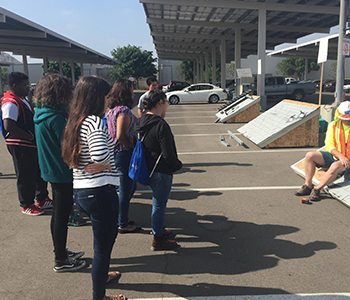
HS Students learning about photovoltaic cells on commercial structures

Outdoor learning laboratory
Indicators of Success
Data is not something to explain away, it is something that needs deep explanation to understand. For many, data is uncomfortable because it reveals shortcomings and can be used inappropriately as a blind evaluation measure. Pretending that class data isn’t important or doesn’t exist is counterproductive. Leading meaningful data chats with grade levels or science departments requires taking the time to develop meaningful relationships with colleagues. Don’t let initial disengagement of peers deter these conversations — looking disinterested is a discomfort coping mechanism. If you are facilitating these conversations, don’t take it personally. Try basic science questions and focus on strategies utilized during instruction rather than on specific courses or teachers. Coming to consensus about pockets of inequity can guide meaningful decisions about course sequencing, course offerings, system supports and outside of the classroom learning opportunities. Data is also a useful tool when guiding conversations about supporting science with administrators.
Ask:
- What do you notice about the data?
- What do you wonder?
- Are there any groups that are disproportionately struggling with this content?
- What learning strategies led to the most successful data?
Strategically Considering Challenges
As we think about transitioning back to school in the Fall, challenges can be found in abundance. An unfortunate consequence of distance learning is that NGSS and Environmental Literacy may be on the backburner of administrative concern, particularly as projected reductions in the governor’s education budget loom. However, the only uncertainty is losing sight of the knowledge and skills students need most. How we, as a science education community, meet this moment is of utmost importance. When an organism's environment changes, the organism adapts, moves or dies. Maybe it’s time to let archaic thinking be laid to rest. Topics that build environmental literacy energize NGSS instruction. Moving forward, consider the opportunities afforded by more actively using outdoor learning spaces. Honor the socio-emotional benefits linked to spending time in nature. Cultivate the excitement of sparking an appreciation and wonder for the natural world. Celebrate that challenges can be met when we remember that district leadership starts with us.
Juanita Chan, STEM and College and Career Pathway Coordinator Rialto Unified School District, CSTA Member.
Lizbeth Mariscal, Science Lead, Rialto Unified School District.




